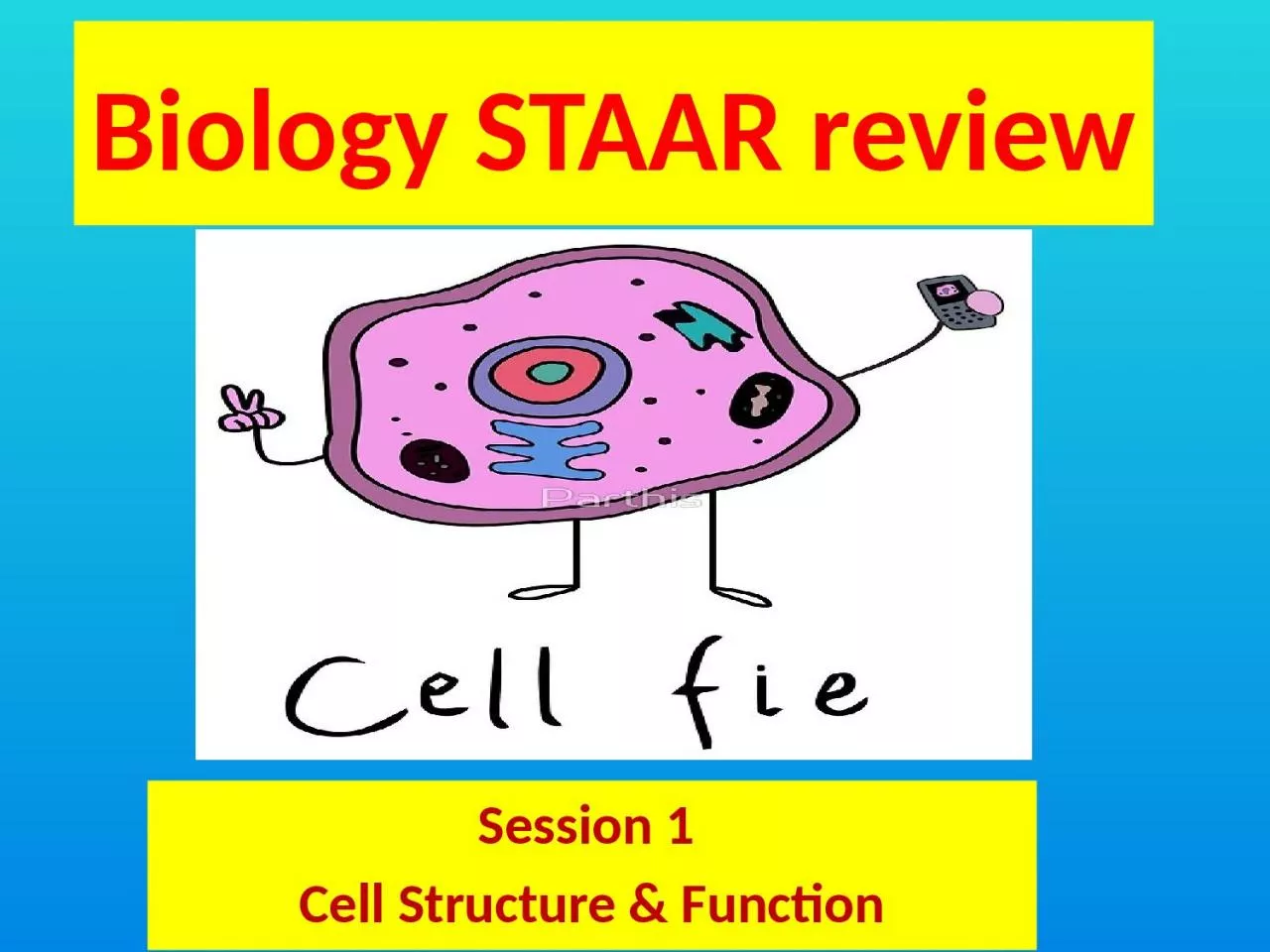

Cell Structure amp Function Housekeeping WELCOME NO EATING OR DRINKING ALLOWED IN THE AUDITORIUM Put away your phones and any other distractions Have handy a pen amp a highlighter Characteristics of Life ID: 929897
Download Presentation The PPT/PDF document "Biology STAAR review Session 1" is the property of its rightful owner. Permission is granted to download and print the materials on this web site for personal, non-commercial use only, and to display it on your personal computer provided you do not modify the materials and that you retain all copyright notices contained in the materials. By downloading content from our website, you accept the terms of this agreement.
Slide1
Biology STAAR review
Session 1 Cell Structure & Function
Slide2Housekeeping…WELCOME!!!!
NO EATING OR DRINKING ALLOWED IN THE AUDITORIUMPut away your phones and any other distractionsHave handy a pen & a highlighter
Slide3Characteristics of Life
Made of CellsReproduce Grow and DevelopRespond to the environment
Obtain and use energy
Slide4Levels of Biological Classification
AtomsBiomolecules
Slide5The Cell…Basic Unit of Life
Prokaryotic (NO – Nucleus)Eukaryotic (True – Nucleus)
Slide6Sort the following terms into your prokaryotic vs eukaryotic Venn diagram
Simple Complex Have DNA Have ribosomes
Have cytoplasm Nucleus NO nucleus
NO organelles
O
rganelles
C
ell membrane
Slide7Slide8Eukaryotic Cell Organelles
Slide9Circle the THREE structures found in plant cells but NOT in animal cells
Slide10Virus Structure
Slide11Are viruses considered living???
Slide12Lytic
Pathway
–
rapid replication of the virus, ending in cell
lysis
(or death). More viruses are released to infect other cells – ex. Influenza
Lysogenic
pathway
The virus stays dormant until certain conditions triggers cause it to enter the lytic cycle – ex. HIV
Slide13Are viruses considered living???
NO!!! They DO NOT meet ALL the characteristics of life!!
Slide14Preventing diseases
Vaccine - a biological preparation that improves immunity to a particular disease. typically made from weakened or killed forms of the microbe.Antibiotics are used to kill bacteria and fungi
NOT viruses
!!!
Slide15ALL cells in human body have the EXACT SAME DNAWhy do they look and function differently? Parts of the DNA within the cell are “turned on” and specialized to perform specific functions.
Cell Specialization
Slide16STAAR Practice Questions
Slide17The projections on the surface of this virus allow the virus to:
move inside a host cell
.
attach to a host cell.
control a host cell’s DNA
.
signal other viruses to infect a host cell.
Question 1
Slide18The projections on the surface of this virus allow the virus to:
move inside a host cell
.
attach to a host cell
.
control a host cell’s DNA
.
signal other viruses to infect a host cell.
Question 1
Slide19Question 7
Severe
acute respiratory syndrome (SARS) is an illness caused by a coronavirus. Symptoms including a high fever, headaches, and body aches typically occur two to seven days after infection by the virus. SARS is more serious in elderly patients. This information suggests that the reproductive cycle of the SARS virus is —
lysogenic, because the virus is a coronavirus
lytic, because the virus causes respiratory illness
lysogenic, because the virus primarily affects older people
lytic, because of the quick onset of symptoms after infection
Question 2
Slide20Question 7
Severe
acute respiratory syndrome (SARS) is an illness caused by a coronavirus. Symptoms including a high fever, headaches, and body aches typically occur two to seven days after infection by the virus. SARS is more serious in elderly patients. This information suggests that the reproductive cycle of the SARS virus is —
lysogenic, because the virus is a coronavirus
lytic, because the virus causes respiratory illness
lysogenic, because the virus primarily affects older people
lytic, because of the quick onset of symptoms after infection
Question 2
Slide21Which
characteristic is shared by all four cells?a. A mechanism for transforming sunlight into energy b. Self-locomotion
c. Membrane-bound
organelles that transport substances
d. Genetic
material composed of DNA
Question 3
Slide22Which
characteristic is shared by all four cells?a. A mechanism for transforming sunlight into energy b. Self-locomotion
c. Membrane-bound
organelles that transport substances
d. Genetic
material composed of DNA
Question 3
Slide23Question 1
Which group of organelles is directly responsible for the production of new molecules like lipids and proteins within a cell?Ribosomes, the endoplasmic reticulum, and Golgi apparatuses
Golgi apparatuses, lysosomes, and the plasma membrane
The endoplasmic reticulum, plastids, and vacuoles
The nucleolus, vacuoles, and ribosomes
Question 4
Slide24Question 1
Which group of organelles is directly responsible for the production of new molecules like lipids and proteins within a cell?Ribosomes, the endoplasmic reticulum, and Golgi apparatuses
Golgi apparatuses, lysosomes, and the plasma membrane
The endoplasmic reticulum, plastids, and vacuoles
The nucleolus, vacuoles, and ribosomes
Question 4
Slide25Proteins and polysaccharides are polymers. These polymers are formed by dehydration synthesis. Which statement correctly identifies a difference in the structure of proteins and polysaccharides?
Only polysaccharides are comprised of repeating units of cytosine, guanine, and thymine.Only proteins are formed from amino acids joined by peptide bonds.
Only polysaccharides can be folded and twisted to very specific shapes.
Only proteins can be large molecules with thousands of subunits.
Question 5
This & many other questions about biomolecules will be answered
WEDNESDAY 4/3
!!!